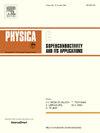Design and analysis of cold mass support system for superconducting magnets without transport protection
IF 1
3区 物理与天体物理
Q4 PHYSICS, APPLIED
Physica C-superconductivity and Its Applications
Pub Date : 2025-06-02
DOI:10.1016/j.physc.2025.1354700
引用次数: 0
Abstract
For the superconducting magnets that require high environmental adaptability during unprotected long-distance transportation, the cold mass support structure must have sufficient rigidity to minimize the variation of coaxiality between the cold mass and the warm bore after transportation. Based on the T700 carbon fiber reinforced plastic (CFRP) with low thermal conductivity and high mechanical strength, a three-dimensional adjustable cold mass support structure is constructed. To monitor the tension forces of the rods and the displacement of the cold mass, the tension sensors and the displacement sensors are integrated into this structure. The support structure is analysed for conductive heat leak, structural strength and stability under vibration. The effects of highway transportation on the displacement of the cold mass and the stress of the rods are studied by vibration experiment. Additionally, the situation of the cold mass may still change under the long-term accumulation of transportation. An adjustment method of the displacement is proposed to solve this problem. The result shows that the displacement of the cold mass is less than 0.01 mm after the vibration experiment. The coaxiality error can be adjusted within 0.1 mm. The rods can support the stress during vibration. The design of the support structure is reasonable and reliable.
无传输保护超导磁体冷质量支撑系统的设计与分析
对于远距离无保护运输对环境适应性要求较高的超导磁体,冷质量支撑结构必须具有足够的刚度,以使冷质量与暖孔之间的同轴度变化最小。基于低导热系数、高机械强度的T700碳纤维增强塑料(CFRP),构建了三维可调冷质量支撑结构。为了监测杆的拉力和冷质量的位移,在该结构中集成了张力传感器和位移传感器。对支撑结构进行了导热漏、结构强度和振动稳定性分析。通过振动试验研究了公路运输对冷质量位移和杆应力的影响。此外,在长期的运输积累下,冷团的情况仍可能发生变化。针对这一问题,提出了一种位移调整方法。结果表明,振动试验后冷质量的位移小于0.01 mm。同轴度误差可在0.1 mm内调节。杆能在振动时承受应力。支撑结构设计合理、可靠。
本文章由计算机程序翻译,如有差异,请以英文原文为准。
求助全文
约1分钟内获得全文
求助全文
来源期刊
CiteScore
2.70
自引率
11.80%
发文量
102
审稿时长
66 days
期刊介绍:
Physica C (Superconductivity and its Applications) publishes peer-reviewed papers on novel developments in the field of superconductivity. Topics include discovery of new superconducting materials and elucidation of their mechanisms, physics of vortex matter, enhancement of critical properties of superconductors, identification of novel properties and processing methods that improve their performance and promote new routes to applications of superconductivity.
The main goal of the journal is to publish:
1. Papers that substantially increase the understanding of the fundamental aspects and mechanisms of superconductivity and vortex matter through theoretical and experimental methods.
2. Papers that report on novel physical properties and processing of materials that substantially enhance their critical performance.
3. Papers that promote new or improved routes to applications of superconductivity and/or superconducting materials, and proof-of-concept novel proto-type superconducting devices.
The editors of the journal will select papers that are well written and based on thorough research that provide truly novel insights.

 求助内容:
求助内容: 应助结果提醒方式:
应助结果提醒方式:


